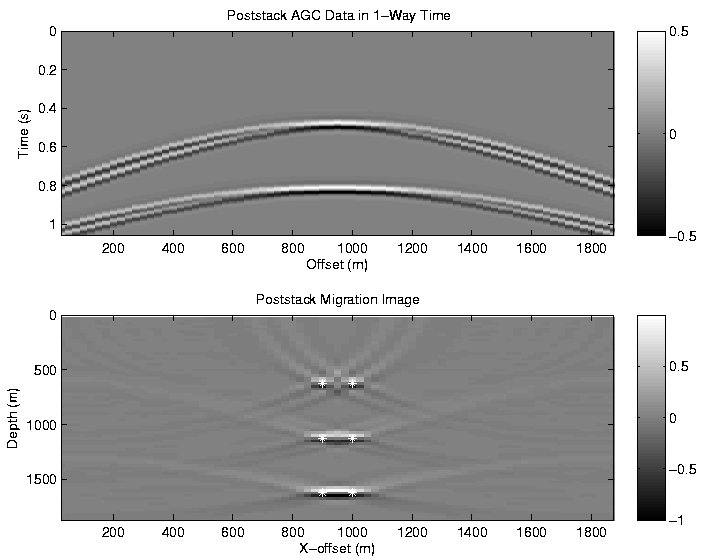Poststack Migration Lab

Figure 1. (Top) Poststack data and (bottom) associated migration image.
There are 6 point scatterers embedded in the homogeneous velocity model
and both modeling and migration are diffraction stack.
Objective: Execute program post.m to reproduce
above figure. The data are produced by ray tracing
and the migration is by diffraction-stack migration.
See exploding reflector lecture here
and poststack migration lecture here.
Procedure and Questions:
- Download the following programs:
post.m, ricker.m,
migrate1.m, model1.m,
plotit.m,
xcorr1.m.
- Type post.m
to generate the above picture for a single scatterer model.
The animation displays the partial migration image as the code sequentially
migrates each trace, one after another.
You will have to adjust the parameter "ioption" value so that
it is set equal to the value "2".
You will also have to change depth of point scatterer.
- Take the migration image and estimate the central width (distance between
two zero crossings) of the scatterer
for different depths. Compare this width
to that of the analytical formula for horizontal resolution limit
dx=lambda z/L, where lambda is the wavelength associated with the
central frequency of the source wavelet, L is the aperture width,
and z is the depth of the scatterer.
- The prestack modeling formula is
d(g,t|s,0) = sum_x W(t-taugx - tausx)R(x)/[|g-x||x-s|]
where R is the reflection coefficient and W(t) is the source wavelet.
- The simple prestack diffraction stack migration formula i migration formula i
distribution, W(t) is the Ricker wavelet, a
distribution, W(t) is the Ricker wavelet, and g, s, x are the vectors
associated with the geophones, sources, and trial image points.
Show that it reduces to the poststack modeling formula when g=s.
- Write a pseudo-Matlab code for implementing the prestack modeling formula.
- The simple prestack diffraction stack migration formula is given by
m(x) = sum_s,g d(g, taugx - tausx|s)
where d(g,t|s) is the 2nd-time derivative of the trace
associated with the src-geophone pair g,s.
From this formula determine the diffraction stack formula for
poststack traces.
- Write a pseudo-Matlab code for implementing the prestack migration formula.
- For a dipping reflector model, use a diagram to show that
poststack migration moves reflections updip from the geophone it is recorded.
From this diagram explain the commonly heard statement
that "migration shortens the apparent width of a dipping reflector".
- Is the best horizontal resolution
(horizontal width of main lobes of
migration butterfly)
achieved for a point scatterer
near the edge of the array or a point scatterer near the middle? Why?
Demonstrate your answer with a numerical example.
- Does the vertical resolution limit (vertical width of migration
vertical width of main lobes of migration butterfly) of a point scatterer image change with depth of point scatterer.
Demonstrate your answer.
